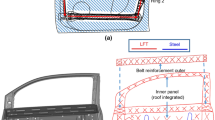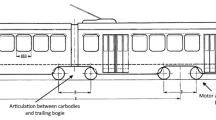Abstract
Chassis frame of electric vehicle contains several thin-walled tube structures that can provide an important component for installing the power unit and supporting the body in white of vehicle. Thus, design a chassis frame is a multi-objective optimization and multi-parameter problem. To address it, the contributions of design variables to the performance indicators of chassis frame are studied first, and obtained the optimal design variables. The effects of the design parameters on the objective responses are analyzed based on a polynomial response surface model. Moreover, to determine optimal solution between the conflicting performance indicators of the chassis frame, an integrated approach based on lightweight and crashworthiness is presented to analysis the performance and determine the Pareto fronts. In addition, the optimal solution is acquired from the Pareto fronts by the grey relational analysis and game theory. Experiments corresponding to the numerical analysis are performed to verify the feasibility of the optimized strategy and the performance of the optimized chassis frame structure. Results show that according to the optimal parameters of chassis frame, the lightweight performance can be improved significantly, while the linear performance and crashworthiness performance of chassis frame are ensured.
















Similar content being viewed by others
References
Prebeg P, Gasparovic G, Krajacic G, Duic N. Long-term energy planning of Croatian power system using multi-objective optimization with focus on renewable energy and integration of electric vehicles. Appl Energy. 2016;184:1493–507. https://doi.org/10.1016/j.apenergy.2016.03.086.
Li Z, Duan LB, Cheng AG, Yao ZP, Chen T, Yao W. Lightweight and crashworthiness design of an electric vehicle using a six-sigma robust design optimization method. Eng Optim. 2019;51:1393–411. https://doi.org/10.1080/0305215X.2018.1521396.
Chen W, Zuo W. Component sensitivity analysis of conceptual vehicle body for lightweight design under static and dynamic stiffness demands. Int J Veh Des. 2014;66:107–23. https://doi.org/10.1504/IJVD.2014.064546.
Wang D, Wang S, Xie C. A multi-objective optimization approach for simultaneously lightweighting and maximizing functional performance of vehicle body structure. Proc Inst Mech Eng Part D J Automob Eng. 2020;234:2086–102. https://doi.org/10.1177/0954407019868140.
Wang D, Wang S. Multi-objective lightweight design of the container S-beam based on MNSGA-II with grey relational analysis. Proc Inst Mech Eng Part C J Mech Eng Sci. 2019;233:3376–87. https://doi.org/10.1177/0954406218823802.
Jiang R, Liu D, Wang D. Multi-objective optimization of vehicle dynamics performance based on entropy weighted TOPSIS method. J Mech Eng. 2018;54:150. https://doi.org/10.3901/JME.2018.02.150.
Zhou P, Du J, Lu Z. Simultaneous topology optimization of supporting structure and loci of isolators in an active vibration isolation system. Comput Struct. 2018;194:74–85. https://doi.org/10.1016/j.compstruc.2017.09.006.
Asanjarani A, Dibajian SH, Mahdian A. Multi-objective crashworthiness optimization of tapered thin-walled square tubes with indentations. Thin-Walled Struct. 2017;116:26–36. https://doi.org/10.1016/j.tws.2017.03.015.
Li Z, Zheng L, Ren Y, Li Y, Xiong Z. Multi-objective optimization of active suspension system in electric vehicle with In-Wheel-Motor against the negative electromechanical coupling effects. Mech Syst Signal Process. 2019;116:545–65. https://doi.org/10.1016/j.ymssp.2018.07.001.
Li Z, Su X, Tan J, Wang H, Wu WW. Multi-objective optimization of the layout of damping material for reducing the structure-borne noise of thin-walled structures. Thin-Walled Struct. 2019;140:331–41. https://doi.org/10.1016/j.tws.2019.03.046.
Wang J, Shen W, Wang Z, Yao M, Zeng X. Multi-objective optimization of drive gears for power split device using surrogate models. J Mech Sci Technol. 2014;28:2205–14. https://doi.org/10.1007/s12206-014-0509-4.
Nariman-Zadeh N, Salehpour M, Jamali A, Haghgoo E. Pareto optimization of a five-degree of freedom vehicle vibration model using a multi-objective uniform-diversity genetic algorithm (MUGA). Eng Appl Artif Intell. 2010;23:543–51. https://doi.org/10.1016/j.engappai.2009.08.008.
Fu S, Wang L, Du Y, Li Z, Zhu Z, Mao E. Application of improved NSGA-II algorithm in matching optimization for tractor powertrain. ASABE Annu Int Virtual Meet. 2020. https://doi.org/10.13031/aim.202000374.
Wang D, Cai K. Optimizing the static–dynamic performance of the body-in-white using a modified non-dominated sorting genetic algorithm coupled with grey relational analysis. Eng Optim. 2018;50:615–33. https://doi.org/10.1080/0305215X.2017.1330888.
Shojaeefard MH, Hosseini SE, Zare J. CFD simulation and Pareto-based multi-objective shape optimization of the centrifugal pump inducer applying GMDH neural network, modified NSGA-II, and TOPSIS. Struct Multidiscip Optim. 2019;60:1509–25. https://doi.org/10.1007/s00158-019-02280-0.
Yu K, Liu Y, Zhang Z. Energy-absorbing analysis and reliability-based multiobjective optimization design of graded thickness B pillar with grey relational analysis. Thin-Walled Struct. 2019;145:106364. https://doi.org/10.1016/j.tws.2019.106364.
Bhattacharya A, Singla S. Dissimilar GTAW between AISI 304 and AISI 4340 steel: multi-response optimization by analytic hierarchy process. Proc Inst Mech Eng Part E J Process Mech Eng. 2017;231:824–35. https://doi.org/10.1177/0954408916641458.
Xiong F, Wang D, Chen S, Gao Q, Tian S. Multi-objective lightweight and crashworthiness optimization for the side structure of an automobile body. Struct Multidiscip Optim. 2018;58:1823–43. https://doi.org/10.1007/s00158-018-1986-3.
Luzon B, El-Sayegh SM. Evaluating supplier selection criteria for oil and gas projects in the UAE using AHP and Delphi. Int J Constr Manag. 2016;16:175–83. https://doi.org/10.1080/15623599.2016.1146112.
Tiwari D, Sherwani AF, Muqeem M, Goyal A. Parametric optimization of organic Rankine cycle using TOPSIS integrated with entropy weight method. Energy Sources Part A Recover Util Environ Eff. 2019. https://doi.org/10.1080/15567036.2019.1649755.
Saha A, Mondal SC. Multi-objective optimization in WEDM process of nanostructured hardfacing materials through hybrid techniques. Meas J Int Meas Confed. 2016;94:46–59. https://doi.org/10.1016/j.measurement.2016.07.087.
Li N, Sheikh-Ahmad JY, El-Sinawi A, Krishnaraj V. Multi-objective optimization of the trimming operation of CFRPs using sensor-fused neural networks and TOPSIS. Meas J Int Meas Confed. 2019;132:252–62. https://doi.org/10.1016/j.measurement.2018.09.057.
Shojaeefard MH, Khalkhali A, Firouzgan A. Multi-objective optimization of a natural aspirated three-cylinder spark ignition engine using modified non-dominated sorting genetic algorithm and multicriteria decision making. J Renew Sustain Energy. 2016. https://doi.org/10.1063/1.4945573.
Annamdas KK, Rao SS. Multi-objective optimization of engineering systems using game theory and particle swarm optimization. Eng Optim. 2009;41:737–52. https://doi.org/10.1080/03052150902822141.
Liu L, Xin Y, Wang W. Multi- objective topology optimization for an off- road vehicle frame based on compromise programming. Mech Sci Technol Aerosp Eng. 2011;30:6–9. https://doi.org/10.13433/j.cnki.1003-8728.2011.03.033.
Huh H, Kim SB, Song JH, Lim JH. Dynamic tensile characteristics of TRIP-type and DP-type steel sheets for an auto-body. Int J Mech Sci. 2008;50:918–31. https://doi.org/10.1016/j.ijmecsci.2007.09.004.
Acknowledgements
This research work was supported by the national key research and development project of china (2016YFB0101601) and Graduate innovation fund of jilin university (101832020CX131).
Author information
Authors and Affiliations
Corresponding author
Ethics declarations
Conflict of interest
No potential conflict of interest was reported by the authors.
Ethics approval
We confirm that this work is original and has not been published elsewhere, nor it is currently under consideration for publication elsewhere. All the authors have approved the manuscript and have agreed with its submission to your journal.
Appendix
Appendix
The cubic polynomial function of M can be expressed as:
The cubic polynomial function of fb can be depicted as:
The cubic polynomial function of ft can be given as:
The cubic polynomial function of St can be written as:
The cubic polynomial function of Sb can be depicted as:
The cubic polynomial function of Bd can be expressed as:
The cubic polynomial function of Al can be given as:
The cubic polynomial function of Ar can be written as:
Rights and permissions
About this article
Cite this article
Wang, S., Wang, D. Crashworthiness-based multi-objective integrated optimization of electric vehicle chassis frame. Archiv.Civ.Mech.Eng 21, 103 (2021). https://doi.org/10.1007/s43452-021-00242-2
Received:
Revised:
Accepted:
Published:
DOI: https://doi.org/10.1007/s43452-021-00242-2




